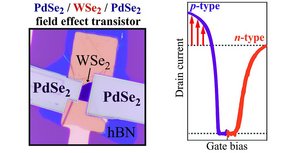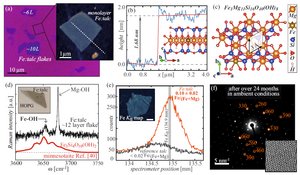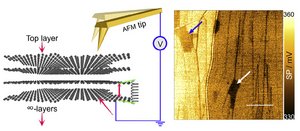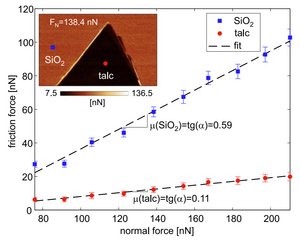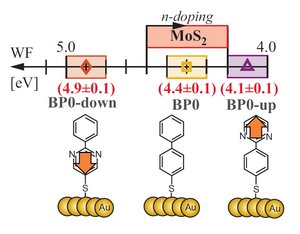Recent publications
Gennadiy Murastov, Awais Aslam, Simon Leitner, Aleksandar Matkovic 2D Mat Lab
We report two-dimensional WSe2 field-effect transistors with multi-layer palladium diselenide (PdSe2) as a contact material. We demonstrate that PdSe2 contacts favour hole injection while preserving the ambipolar nature of the channel material. This consequently yields high-performance p-type WSe2 devices with PdSe2 van der Waals contacts. Further, we explore the tunability of the contact interface by selective laser alteration of the WSe2 under the contacts, enabling pinning of the threshold voltage to the valence band of WSe2, yielding pure p-type operation of the devices.
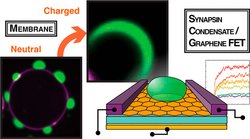
Electric Potential at the Interface of Membraneless Organelles Gauged by Graphene
Christian Hoffman, Gennadiy Murastov, Johannes Vincent Tromm, Muhammad Awais Aslam, Aleksandar Matkovic, Dragomir Milovanovic 2D_Mat_Lab
Eukaryotic cells contain membrane-bound and membrane-less organelles that are often in contact with each other. How the interface properties of membrane-less organelles regulate their interactions with membranes remains challenging to assess. Here, we employ graphene-based sensors to investigate the electrostatic properties of synapsin 1, a major synaptic phosphoprotein, either in a single phase or after undergoing phase separation to form synapsin condensates. Using these graphene-based sensors, we discover that synapsin condensates generate strong electrical responses that are otherwise absent when synapsin is present as a single phase. By introducing atomically thin dielectric barriers, we show that the electrical response originates in an electric double layer whose formation governs the interaction between synapsin condensates and graphene. Our data indicate that the interface properties of the same protein are substantially different when the protein is in a single phase versus within a biomolecular condensate, unraveling that condensates can harbor ion potential differences at their interface.
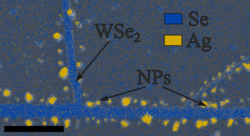
Gennadiy Murastov Muhammad Awais Aslam, Aleksandar Matkovic 2D Mat_Lab
Combining metallic nanoparticles and 2D semiconductors is a promising pathway to tailor hybrid mixed-dimentional plasmonic systems. However, current research focuses on either stacking nanopartiles on 2D layers or vice versa, commonly compromising electronic properties of the 2D materials due to perturbation of its basal plane. Here, we report a direct one-step controllable growth of silver nanoparticles along tungsten diselenide nanoribbon edges via edge-specific on-surface photochemistry for boosting light-matter coupling effect, optoelectronic response, and improving photocatalytic performance.
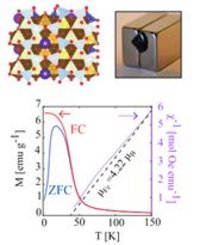
Probing magnetic ordering in air stable iron-rich van der Waals minerals
M. Z. Khan et.al. ArXiv pre-print (arXiv:2304.06533)/ 2DMat_Lab
In the rapidly expanding field of two-dimensional materials, magnetic monolayers show great promise for the future applications in nanoelectronics, data storage, and sensing. The research in intrinsically magnetic two-dimensional materials mainly focuses on synthetic iodide and telluride based compounds, which inherently suffer from the lack of ambient stability. So far, naturally occurring layered magnetic materials have been vastly overlooked. These minerals offer a unique opportunity to explore air-stable complex layered systems with high concentration of local moment bearing ions. We demonstrate magnetic ordering in iron-rich two-dimensional phyllosilicates, focusing on mineral species of minnesotaite, annite, and biotite. These are naturally occurring van der Waals magnetic materials which integrate local moment baring ions of iron via magnesium/aluminium substitution in their octahedral sites. Due to self-inherent capping by silicate/aluminate tetrahedral groups, ultra-thin layers are air-stable. Chemical characterization, quantitative elemental analysis, and iron oxidation states were determined via Raman spectroscopy, wavelength disperse X-ray spectroscopy, X-ray absorption spectroscopy, and X-ray photoelectron spectroscopy. Superconducting quantum interference device magnetometry measurements were performed to examine the magnetic ordering. These layered materials exhibit paramagnetic or superparamagnetic characteristics at room temperature. At low temperature ferrimagnetic or antiferromagnetic ordering occurs, with the critical ordering temperature of 38.7 K for minnesotaite, 36.1 K for annite, and 4.9 K for biotite. In-field magnetic force microscopy on iron bearing phyllosilicates confirmed the paramagnetic response at room temperature, present down to monolayers.
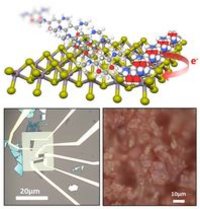
Electrical monitoring of organic crystal phase transition using MoS2 field effect transistor
I. Boulet et.al. Nanoscale Advances 5, 1681–1690, 2023, 2D_Mat_Lab SPMG
Hybrid van der Waals heterostructures made of 2D materials and organic molecules exploit the high sensitivity of 2D materials to all interfacial modifications and the inherent versatility of the organic compounds. In this study, we are interested in the quinoidal zwitterion/MoS2 hybrid system in which organic crystals are grown by epitaxy on the MoS2 surface and reorganize in another polymorph after thermal annealing. By means of field-effect transistor measurements recorded in situ all along the process, atomic force microscopy and density functional theory calculations we demonstrate that the charge transfer between quinoidal zwitterions and MoS2 strongly depends on the conformation of the molecular film. Remarkably, both the field effect mobility and the current modulation depth of the transistors remain unchanged which opens up promising prospects for efficient devices based on this hybrid system. We also show that MoS2 transistors enable fast and accurate detection of structural modifications that occur during phases transitions of the organic layer. This work highlights that MoS2 transistors are remarkable tools for on-chip detection of molecular events occurring at the nanoscale, which paves the way for the investigation of other dynamical systems.
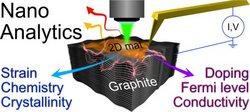
A universal substrate for the nanoscale investigation of two-dimensional materials
T.H. Tran et.al., Applied Surface Science 604, 154585, 2022.2D Mat_Lab
Since discovering two-dimensional materials, there has been a great interest in exploring, understanding, and taking advantage of their unique properties. Si/SiO2 is one of the most used substrates for the deposition and characterization of 2D materials due to its availability and optical contrast. This work goes beyond the conventional substrate and introduces highly-ordered pyrolytic graphite (HOPG) as universal support for investigating two-dimensional materials due to several unique properties such as chemical and temperature stability, intrinsic high flatness, reusability, electrical conductivity, ease of use, availability, and enhanced adhesion of two-dimensional materials. We demonstrate this by analyzing several 2D materials with advanced atomic force microscopy methods, Raman and photoluminescence spectroscopy with hyperspectral imaging, and scanning electron microscopy with elementary analysis imaging. The strong adhesion to HOPG allowed the instant deposition of different two-dimensional materials GaSe, MoS2, Zn2In2S5, talc, and h-BN. This feat is hard to accomplish on the conventional SiO2 substrate without polymer-assisted transfer. Moreover, this strong interaction can strain 2D materials deposited on HOPG, giving localized changes in reactivity, optical, and electronic properties. This effect is explored for selective Ag deposition on strained regions of 2D materials to activate photocatalytic reactions.
www.sciencedirect.com/science/article/pii/S0169433222021171
Pinaceae Fir Resins as Natural Dielectrics
J. Ivic et.al., Advanced Sustainable Systems *, 2200234, 2022.
In this study, lead by our collaborators from Joanneum Research Materials Weiz and Johannes Kepler University Linz, we demonstrate a natural resin based gate dielectrics for high performance organic electronics:
"Natural dielectrics are emerging nowadays as a niche selection of materials for applications targeting biocompatibility and biodegradability for electronics and sensors within the overall effort of scientific community to achieve sustainable development and to build environmental consciousness. The two natural resins analyzed in this study, silver fir and Rocky mountain fir demonstrate robust dielectric properties and excellent film forming capabilities, while being trap free dielectrics in high-performance organic field effect transistors (OFETs) operating at voltages as low as 1 V. Immense research possibilities are demonstrated through the avenue of inorganic nanofillers insertions in the natural resins film, that opens the door for fabrication of very low voltage OFETs with high dielectric constant insulating layers."
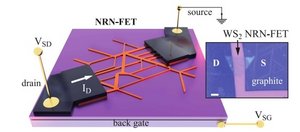
Single Crystalline 2D Material Nanoribbon Networks for Nanoelectronics
Muhammad Awais Aslam
The last decade has seen a flurry of studies related to graphene nanoribbons owing to their potential applications in the quantum realm. However, little experimental work has been reported towards nanoribbons of other 2D materials due to the absence of synthesis routes. Here, we propose a universal approach to synthesize high-quality networks of nanoribbons from arbitrary 2D materials while maintaining high crystallinity, sufficient yield, narrow size distribution, and straight-forward device integrability. The wide applicability of this technique is demonstrated by fabricating MoS2, WS2, WSe2, and graphene nanoribbon field effect transistors that inherently do not suffer from interconnection resistances. By relying on self-assembled and self-aligned organic nanostructures as masks, we demonstrate the possibility of controlling the predominant crystallographic direction of the nanoribbon’s edges. Electrical characterization shows record mobilities and very high ON currents for various TMDCs despite extreme width scaling. Lastly, we explore decoration of nanoribbon edges with plasmonic particles paving the way towards the development of nanoribbon-based plasmonic sensing and opto-electronic devices.
Iron-rich talc as air-stable platform for magnetic two-dimensional materials
A Matkovic, et.al., npj 2D materials and applications 5, 94, 2021
By combining SQUID magnetometry, in-field MFM, and detailed structural characterization, we have revealed weak ferromagnetic ordering in Fe:talc that persist at room temperature. Further, monolayers of this magnetic insulator are fully air-stable.
Twisted graphene in graphite: Impact on surface potential and chemical stability
T-H Tran, et.al., Carbon 176, 431-439, 2021
We have explored the influence of the structural defect on electronic and chemical stability of a freshly cleaved HOPG surface. By combined advanced AFM methods and co-local Raman and KPFM mapping, we show how twisted layers in HOPG affect its electronic structure and ambient stability.
Two-dimensional talc as a van der Waals material for solid lubrication at the nanoscale
B. Vasic, et.al., Nanotechnology 32, 265701, 2021.
We investigate 2D talc flakes down to single layer thickness and reveal their efficiency for solid lubrication at the nanoscale. We demonstrate by atomic force microscopy based methods and contact angle measurements that several nanometer thick talc flakes have all properties necessary for efficient lubrication: a low adhesion, hydrophobic nature, and a low friction coefficient.
Interfacial Band Engineering of MoS2/Gold Interfaces Using Pyrimidine-Containing Self-Assembled Monolayers: Toward Contact-Resistance-Free Bottom-Contacts
A. Matkovic, et.al., Advanced Electronic Materials 6, 2000110, 2020.
Pyrimidine-containing self-assembled monolayers on gold electrodes are investigated for tuning the electrode work functions in order to minimize that contact resistance. Their frequently ignored asymmetric and bias-dependent nature is recorded by Kelvin probe force microscopy through a direct mapping of the potential drop across the channel during device operation. A reduction of the contact resistances exceeding two orders of magnitude is achieved via a suitable self-assembled monolayer, which vastly improves the overall device performance.

